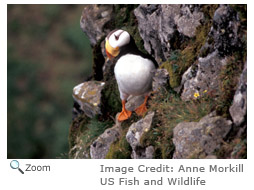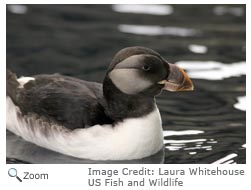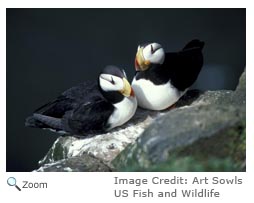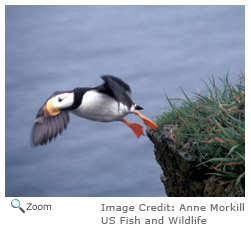Description  The horned puffin is a small, pigeon-sized bird with black uppersides and a white chest and undersides. It has a white face and cheeks with a small black "horn" above its eyes and a thin, dark line that runs from its eyes to the nape of its neck. It has a large, triangular orange bill with a red tip. It has bright orange legs and webbed feet with claws on the ends of them. The horned puffin is a small, pigeon-sized bird with black uppersides and a white chest and undersides. It has a white face and cheeks with a small black "horn" above its eyes and a thin, dark line that runs from its eyes to the nape of its neck. It has a large, triangular orange bill with a red tip. It has bright orange legs and webbed feet with claws on the ends of them.
 In the winter, the horned puffin's bill is smaller, its feathers are grayer, and its face is darker. Males and females look similar, but the male's bill is bigger and brighter than the female's bill and the male is a little larger. Because of its colorful bill, the horned puffin is sometimes called the sea parrot. In the winter, the horned puffin's bill is smaller, its feathers are grayer, and its face is darker. Males and females look similar, but the male's bill is bigger and brighter than the female's bill and the male is a little larger. Because of its colorful bill, the horned puffin is sometimes called the sea parrot.
 Horned puffins exhibit a type of deceptive coloration called counter shading. Animals with countershading have different colors on their backs and stomachs. The puffin's dark coloring on the top makes it hard for predators above them in the water to see them, because the puffin blends into the dark water. The light coloring on the underside of the puffin helps them to blend into the sunlit water above and makes locating the puffin more difficult for predators swimming under them. Horned puffins exhibit a type of deceptive coloration called counter shading. Animals with countershading have different colors on their backs and stomachs. The puffin's dark coloring on the top makes it hard for predators above them in the water to see them, because the puffin blends into the dark water. The light coloring on the underside of the puffin helps them to blend into the sunlit water above and makes locating the puffin more difficult for predators swimming under them.
Range  The horned puffin breeds from northern Alaska to British Columbia in Canada. It winters in the ocean off the coast from Alaska to Washington. Occasionally, stragglers make their way down as far south as southern California. The horned puffin breeds from northern Alaska to British Columbia in Canada. It winters in the ocean off the coast from Alaska to Washington. Occasionally, stragglers make their way down as far south as southern California.
| |
Habitat
 The horned puffin is pelagic. A pelagic animal lives on the open sea. In breeding season, it is found on sea cliffs or on rocky islets. The horned puffin is pelagic. A pelagic animal lives on the open sea. In breeding season, it is found on sea cliffs or on rocky islets.
Diet
 The horned puffin uses its large bill to catch fish and marine invertebrates. It can dive up to depths of 80 feet to catch its prey. The horned puffin can carry more than one fish in its mouth at a time. The horned puffin uses its large bill to catch fish and marine invertebrates. It can dive up to depths of 80 feet to catch its prey. The horned puffin can carry more than one fish in its mouth at a time.
Life Cycle
 In the summer, puffins come in from the open ocean to mate. Puffins form pairs that mate for life. A pair usually builds a nest in a crevice in a cliff or in a hole between boulders. The female lays only one egg a year. In the summer, puffins come in from the open ocean to mate. Puffins form pairs that mate for life. A pair usually builds a nest in a crevice in a cliff or in a hole between boulders. The female lays only one egg a year.
 Both parents incubate the egg. They place the egg under a wing and then lean their body against the egg. The egg hatches in about 40 days and both parents feed and protect the chick. When the chick fledges in 40 days, the parents leave the chick and return to the open ocean. The chick then goes out to the open ocean waters and remains there for at least two years. Puffins breed in large colonies with the tufted puffin. Both parents incubate the egg. They place the egg under a wing and then lean their body against the egg. The egg hatches in about 40 days and both parents feed and protect the chick. When the chick fledges in 40 days, the parents leave the chick and return to the open ocean. The chick then goes out to the open ocean waters and remains there for at least two years. Puffins breed in large colonies with the tufted puffin.
Behavior
 The horned puffin's legs are set well back on its body, and it is not very graceful on land, but it is a very good swimmer. It uses its wings to propel itself in the water and its legs to maneuver. The horned puffin's legs are set well back on its body, and it is not very graceful on land, but it is a very good swimmer. It uses its wings to propel itself in the water and its legs to maneuver.
The puffin can fly, but it is a better swimmer. In order to get airborne, the puffin must run on the surface of the water for a long distance. The horned puffin also dives off cliffs to take flight.
|




 The horned puffin breeds from northern Alaska to British Columbia in Canada. It winters in the ocean off the coast from Alaska to Washington. Occasionally, stragglers make their way down as far south as southern California.
The horned puffin breeds from northern Alaska to British Columbia in Canada. It winters in the ocean off the coast from Alaska to Washington. Occasionally, stragglers make their way down as far south as southern California. 



